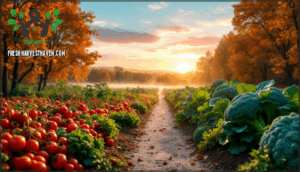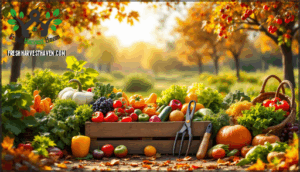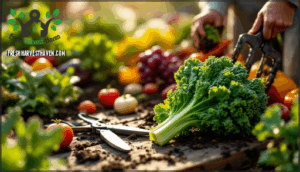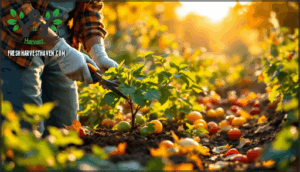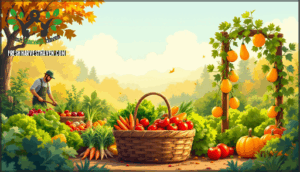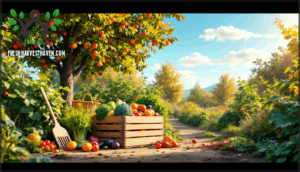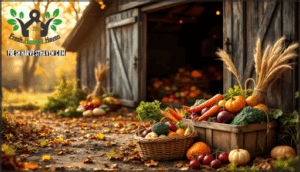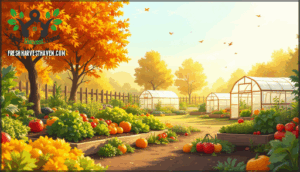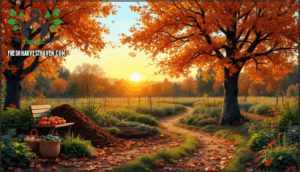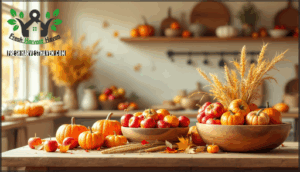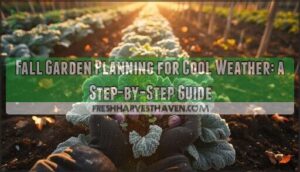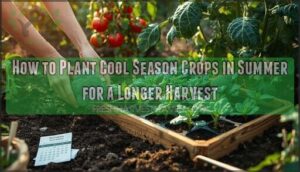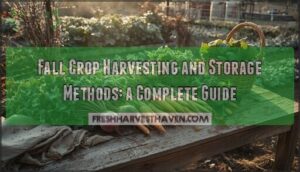This site is supported by our readers. We may earn a commission, at no cost to you, if you purchase through links.
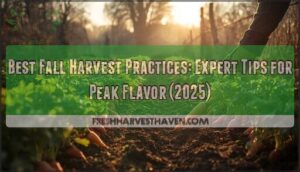
Unlike summer crops that announce their readiness with obvious color changes, autumn vegetables play a subtler game where timing intersects with dropping temperatures, shifting daylight, and the particular needs of each variety.
The difference between bland roots and sugar-rich vegetables often comes down to understanding when cold weather becomes your ally rather than your enemy. Master the best fall harvest practices, and you’ll transform your garden’s final act into its most flavorful performance—one that fills your root cellar and extends fresh eating well into winter.
Table Of Contents
- Key Takeaways
- Choosing The Best Fall Vegetables
- Timing Your Fall Harvest for Peak Flavor
- Essential Tools and Techniques for Harvesting
- Harvesting Strategies for Different Vegetables
- Maximizing Flavor and Nutrition at Harvest
- Post-Harvest Handling and Storage Solutions
- Extending The Harvest Season
- Fall Garden Maintenance and Soil Care
- Preserving and Enjoying Your Fall Harvest
- Frequently Asked Questions (FAQs)
- Conclusion
Key Takeaways
- Timing your fall harvest around the first light frost is critical because cold triggers sugar conversion in vegetables like carrots, kale, and Brussels sprouts (increasing sweetness by up to 50%), but waiting too long risks a hard freeze that turns crops to mush.
- Vegetables grown in soil with over 5% organic matter show 25% more flavor diversity, and proper soil health—including balanced pH (6.0-7.0) and minerals like potassium—directly boosts sugar content and taste by up to 18% in crops like peppers.
- Post-harvest handling makes the difference between weeks and months of storage: root vegetables need 85-95% humidity at near-freezing temps without washing, while winter squash requires curing at 80°F for 10-14 days and then storage at 50-60°F with low humidity.
- Succession planting fast-maturing crops every 2-3 weeks combined with row covers or frost blankets can extend your harvest season by 4-6 weeks and boost yields 30-80% over single plantings, keeping fresh produce coming until hard frost.
Choosing The Best Fall Vegetables
Choosing the right fall vegetables sets you up for a successful harvest season. Your picks should match your climate, growing timeline, and how you want to use your space.
Let’s look at what makes certain crops shine in autumn gardens.
Characteristics of Ideal Fall Crops
When autumn rolls around, the best crops for your garden share a few winning traits: they can withstand a chill, they grow fast enough to beat the hard frosts, and they actually taste better when the temperatures drop. Look for crop varieties with strong fall hardiness and climate tolerance:
- Leafy greens like kale that shrug off light freezes
- Root vegetables such as carrots that sweeten after frost
- Crops with modest nutrient requirements that thrive in cooler soil
- Vegetables bred specifically for shorter fall growing windows
Fast-Maturing and Frost-Tolerant Varieties
You want varieties that mature quickly and withstand freezes. Asian Delight bok choy reaches harvest in just 37 days, while Purple Top Milan turnips are ready in 30–35 days. Radishes? Some finish in 20–30 days.
For cold hardiness, kale tolerates temperatures down to 5°F and tastes sweeter after frost. Carrots withstand 15°F and gain sweetness, too. Swiss chard combines both traits—maturing in 50–60 days while surviving 15°F lows for extended harvests.
Understanding cold hardy vegetables is key to a successful fall harvest.
Vegetables for Continuous and Extended Harvest
For a harvest that keeps giving week after week, you’ll need crops that either regrow after cutting or can be picked continuously throughout the season. Leafy greens like lettuce and spinach are perfect—just snip outer leaves and they’ll keep producing.
Succession planting fast growers every two weeks guarantees non-stop harvests. Pair this with crop rotation and soil enrichment to maintain vegetable diversity while extending your season naturally.
Timing Your Fall Harvest for Peak Flavor
Knowing when to harvest can make the difference between good vegetables and truly outstanding ones. Your timing depends on maturity guidelines, local weather patterns, and visual cues from the plants themselves.
Let’s break down how to nail the perfect harvest window for maximum flavor and nutrition.
Using Seed Packets to Estimate Maturity
Your seed packet isn’t just pretty packaging—it’s a calendar that tells you exactly when your vegetables will be ready to pick. Look for "days to maturity" printed clearly on the packet information—this number tells you how long from sowing (or transplanting) until harvest.
Regional climate impact matters, though. Cool fall temperatures can add a week or two beyond the maturity dates listed, so factor that into your harvest timing and variety selection.
How Weather Affects Harvest Timing
Beyond the numbers on your seed packet, weather patterns can throw your harvest timing off track. Drought impact in 2024 and 2025 left 77% of U.S. farmland abnormally dry, causing crops to mature unevenly and pushing back harvest dates. Conversely, excessive rainfall—like Illinois’s record-breaking June 2015—triggers harvest delays by waterlogging fields and spreading disease. Frost damage forces early emergency harvests when temperatures drop to 32°F, while climate shifts with persistent heat above 95°F speed ripening but compromise quality.
Watch fall harvest conditions closely and stay flexible with your schedule. Farmers must also consider the effects of corn belt weather on their crop yields and planning.
Signs Your Crops Are Ready to Harvest
Knowing when to pick is half art, half science—your crops won’t send you a text when they’re ready, but they’ll give you plenty of visual and tactile clues if you know what to look for. Watch for these harvest signs at peak ripeness:
- Size and color shifts – Carrots show vibrant orange crowns pushing through soil; kale leaves darken to deep green
- Texture tells the story – Squeeze winter squash; hard rinds signal maturity and flavor peaks
- Growth stages plateau – When leafy greens stop expanding, crop readiness hits its ideal point for harvesting techniques
Essential Tools and Techniques for Harvesting
Having the right tools makes all the difference when it’s time to bring in your fall crops. Clean, sharp equipment protects your plants from damage and helps your harvest last longer in storage.
Let’s look at the essential tools you’ll need and how to use them properly.
Must-Have Harvesting Tools Explained
The right tools don’t just make harvest day easier—they’re the difference between bruised, broken vegetables and a flawless crop that stores beautifully for months. Sharp cutters like harvesting knives for cabbage and broccoli, pruning shears for precise snipping of peppers and beans, and garden forks to gently lift roots without damage are essential.
Clean, well-maintained gardening tools protect your harvest and prevent disease from spreading through your beds.
Proper Use of Knives, Shears, and Forks
Each tool has its moment—use a knife to slice clean through the base of kale or cabbage without crushing stems, shears to snip peppers and beans without tugging the plant, and a garden fork to loosen soil around roots so you can lift carrots and beets without snapping them in half.
Sharp tool maintenance and proper blade selection make all the difference. Clean your harvesting knife and pruning shears between plants, angle cuts at the stem’s base, and work the fork gently outward to avoid severing roots underground.
Tips to Avoid Plant Damage and Disease
Sloppy habits—wet tools, rough treatment, or working through diseased plants—turn your garden into a breeding ground for trouble faster than you’d think. Clean tools with a bleach solution between rows, keep sharp blades ready for smooth cuts, and practice gentle care to avoid bruising tissue that invites infection.
Soil sanitation and careful disease prevention protect your harvest and next season’s soil health.
Harvesting Strategies for Different Vegetables
Not every vegetable comes out of the ground the same way, and knowing the right approach for each type makes all the difference. From tender greens to hardy roots, each crop has its own ideal time for harvest.
Let’s break down the best techniques for the three main categories you’ll be working with this fall.
Best Practices for Leafy Greens
Leafy greens don’t wait around—harvest them at just the right size, and you’ll get tender, flavorful leaves that can keep producing all season long. For kale management and spinach growing, cut outer leaves first, leaving the center intact for continuous harvest.
With lettuce cultivation, harvest in early morning after dew dries—this simple harvest timing trick locks in crispness and extends storage life, making your fall vegetable harvest truly rewarding.
Root Vegetable Harvest Tips
Root vegetables work a little differently—they’re hidden underground, so you’ll need to read the signs above the soil and use the right technique to pull them without damage.
Root vegetable harvest timing depends on these indicators:
- Check Days to Maturity – Your seed packet reveals expected harvest timing for carrots, beets, and radishes after soil preparation and root growth.
- Watch Foliage Color – Yellowing tops signal readiness for harvesting fall vegetables.
- Test Crown Size – When carrot or beet crowns peek above soil, they’re ready for your fall vegetable harvest.
- Loosen Soil First – Use a garden fork to gently lift roots without snapping them during postharvest management and storage.
- Plan Crop Rotation – Rotate root crops yearly to maintain soil health and improve future storage methods.
Harvesting Squash, Pumpkins, and Beans
While roots hide beneath the surface, squash, pumpkins, and beans announce their readiness right on the vine—you just need to know what signals to watch for.
Harvest timing for squash varieties and pumpkins depends on these cues:
| Crop | Ready-to-Harvest Signs |
|---|---|
| Winter Squash | Hard rind resists fingernail pressure; stem dries and browns |
| Pumpkins | Deep, uniform color; hollow sound when tapped; dried stem |
| Summer Squash | Glossy skin at 6-8 inches; soft rind yields to gentle pressure |
| Pole Beans | Firm, crisp pods snap cleanly; seeds barely visible inside |
| Bush Beans | Harvest every 2-3 days to encourage continued production |
Use harvesting techniques like pruning shears for clean cuts during harvesting fall vegetables, and manage carefully to avoid bruising before gourd storage.
Maximizing Flavor and Nutrition at Harvest
Your harvest’s flavor doesn’t happen by chance—it’s shaped by soil health, temperature, and timing. The best fall vegetables come from gardens where these three elements align just right.
Here’s how to make sure your crops taste as good as they possibly can.
Impact of Soil Health on Taste
Your soil speaks directly to your vegetables’ flavor. Think of it as the foundation of taste—vegetables grown in soil with more than 5% organic matter show a 25% increase in flavor compound diversity. That’s soil health improvement at work.
Soil mineral impact matters too: potassium-rich soil boosts sugar content in peppers by 18%, while zinc and copper heighten the pungency in onions and garlic. Microbial flavor comes from trace element influence and pH balance—ideal levels between 6.0 and 7.0 increase sugar concentration by 17%.
How Cold Weather Enhances Sweetness
Nature triggers a striking transformation when temperatures drop: cold sweetening. At air temperatures below 5°C (41°F), your fall vegetables begin converting starches into sugars—a survival mechanism that doubles as a flavor boost. Root vegetables like carrots, beets, and parsnips can increase their sugar content by up to 50% after frost exposure, while leafy greens and Brussels sprouts shed bitterness and gain noticeable sweetness. This vegetable physiology adaptation protects plant cells from freezing damage by acting as natural antifreeze.
When temperatures drop below 41°F, fall vegetables convert starches into sugars as natural antifreeze, sweetening carrots and beets by up to 50% after frost
Winter harvesting advantages include:
- Sugar accumulation in carrots raises sweetness by 10% or more after sustained cold
- Frost tolerance in kale and Brussels sprouts amplifies flavor after multiple frost events
- Improved Brix values signal measurably sweeter harvesting fall vegetables
- Enhanced nutrition with higher vitamin C and antioxidant levels
- Better storage life due to increased sugar concentrations
Harvest timing matters—wait until after the first light frost for peak flavor in cold-hardy crops.
Harvest Timing for Optimal Nutrition
Timing your harvest to coincide with peak ripeness doesn’t just boost flavor—it also secures the highest levels of vitamins, antioxidants, and essential nutrients your fall vegetables can deliver. Harvest scheduling based on these patterns secures flavor enhancement and ideal health benefits.
Maturity checks and crop monitoring are essential—leafy greens reach nutrient peaks early, while root vegetables build nutritional density closer to full maturity. Harvesting fall vegetables at their nutritional prime means monitoring days to maturity and adjusting for weather conditions.
| Vegetable Type | Nutrient Peak Timing |
|---|---|
| Leafy greens | Harvest at young to medium maturity for highest vitamin C |
| Root vegetables | Wait until full size develops for maximum antioxidants |
| Brassicas | Harvest after light frost for enhanced glucosinolates |
Post-Harvest Handling and Storage Solutions
You’ve done the hard work of growing your fall harvest—now it’s time to make it last. The way you manage and store vegetables after picking makes all the difference between enjoying them for weeks or watching them wilt away.
Let’s walk through the essential steps to keep your harvest fresh, flavorful, and ready to enjoy all season long.
Inspecting and Cleaning Your Harvest
The moment you pull that last carrot or snip the final head of lettuce, your real work as a gardener begins—because a careful inspection now can mean the difference between vegetables that last for months and produce that spoils within days.
Start your harvest inspection by looking for cuts, bruises, or soft spots that invite decay. Remove damaged portions immediately—they won’t improve in storage.
For crop cleaning, gently brush off excess soil from root vegetables rather than washing them, which can reduce shelf life and complicate postharvest management.
Storage Methods for Roots, Greens, and Squash
Success in postharvest management demands precise humidity control and ethylene management for your fall vegetable gardening.
Store root vegetables like carrots and beets at 0–10°C with 85–95% humidity in ventilated containers layered with moist sand—they’ll last 4–8 weeks. Keep leafy greens at 1.7–4.5°C in perforated bags with damp towels for 10+ days of crispness.
Winter squash preservation requires 10–16°C and 50–70% humidity in well-ventilated spaces for 2–6 months of storage. Never store roots with squash—different humidity needs spell trouble.
Curing Techniques for Long-Term Storage
Curing transforms freshly harvested vegetables into storage champions, turning weeks of shelf life into months through controlled drying that toughens skins and seals in quality.
Winter squash needs 10–14 days at 27°C with good airflow to cure properly. Onions and garlic require warm, dry conditions—spread them in single layers until papery skins form.
These curing methods fine-tune moisture levels and create protective barriers that dramatically extend your harvest’s lifespan.
Extending The Harvest Season
You don’t have to call it quits when the first frost threatens your garden. A few smart strategies can keep your crops producing well beyond their normal timeline.
Let’s look at two proven methods that’ll help you squeeze more fresh vegetables out of your fall garden.
Using Row Covers and Frost Blankets
Extending your growing season doesn’t require a greenhouse—sometimes all you need is a simple layer of protection between your plants and that first killing frost. Row covers and frost blankets act like a cozy shield, trapping warmth while letting light and moisture through.
These frost protection tools can extend your season by several weeks, giving cold-sensitive crops time to mature while boosting frost tolerance in hardy greens and roots.
Succession Planting for Continuous Crops
Want to harvest fresh veggies all autumn long? Succession planting
- Seed selection matters: Choose fast-maturing varieties like lettuce, radishes, and spinach for fall gardening tips success
- Planting schedules work best at 14-day intervals, creating overlapping harvest windows that extend 4-6 weeks
- Crop rotation prevents disease buildup when you’re planting the same bed multiple times
- Soil fertility needs monitoring—successive sowings drain nutrients fast, so amend between rounds
- Season extension methods like cold frames paired with succession planting can boost yields 30-80% over single plantings
Fall Garden Maintenance and Soil Care
Once the harvest winds down, your fall garden still needs attention to set the stage for next year’s success. A little end-of-season care protects your soil, prevents pest and disease carryover, and keeps your tools in working order.
Let’s walk through three essential maintenance tasks that’ll pay off when spring rolls around.
Cleaning Beds and Removing Debris
Once your vegetables are safely stored, it’s time to turn your attention to the garden beds themselves—because what you do now sets the stage for next season’s success. Start your fall garden maintenance by pulling out spent plants, roots and all—they can harbor pests and diseases over winter. Remove weeds before they drop seeds, then rake up fallen leaves and debris.
This garden cleanup isn’t just tidying; it’s soil sanitizing and bed preparation that gives you real control over next year’s growing conditions.
Mulching and Cover Crops for Soil Health
After clearing away the season’s debris, your next move is protecting what’s left behind—and mulching or planting cover crops does exactly that while feeding the soil for spring.
Here’s what these soil amendments accomplish:
- Mulch insulates roots, retains moisture, and breaks down into organic matter
- Cover crops like winter rye prevent soil erosion and boost microbe balance
- Crop rotation planning now guarantees healthier beds and better compost benefits next year
Both strategies improve soil health dramatically before winter sets in.
Sanitizing Tools to Prevent Disease
Your pruners and shovels carry more than soil from bed to bed—they can spread fungal spores, bacterial blights, and viral diseases that’ll sabotage next season before it even starts. That’s why tool sterilization matters for disease prevention and effective pest control methods.
After each use, wipe blades clean, then dip them in a bleach solution (one part bleach to nine parts water) for proper equipment maintenance. This simple cleaning method stops garden pests and disease from hitchhiking between plants, protecting your investment all winter long.
Preserving and Enjoying Your Fall Harvest
After all your careful planning and harvesting, it’s time to make the most of your fall bounty. The way you store, prepare, and preserve these crops can extend their life for months and deepen your connection to the growing season.
Let’s explore practical ways to turn your harvest into meals, preserved goods, and traditions worth sharing.
Classic Fall Cooking Recipes
Nothing beats the comfort of roasting a big pan of fall vegetables drizzled with olive oil, tossed with fresh herbs, and pulled from the oven golden and caramelized.
Try hearty fall soups with butternut squash or harvest salads featuring roasted beets and kale.
Don’t forget seasonal desserts like pumpkin bread or apple crisp—these comfort foods showcase your fall crops beautifully and make preserving fall vegetables through cooking a delicious tradition.
Fermenting and Preserving Techniques
Lactic acid fermentation turns your surplus cabbage, carrots, and cucumbers into tangy treasures that last for months. You’ll want to aim for a 2% salt concentration and keep your ferment tools—like fido jars or pickle pipes—at room temperature between 65°F and 72°F for best results.
This preservation method extends shelf life and boosts food safety by creating an acidic environment that wards off spoilage. Once fermented, store your sauerkraut and kimchi in a cool, dark spot for up to a year.
Sharing and Celebrating Fall Harvest Traditions
Fall harvest brings neighbors together in ways that echo traditions as old as agriculture itself—community potlucks, farmers market swaps, and porch-step gift baskets turn surplus produce into shared joy.
Harvest festivals celebrate the autumn harvest season with fall recipes, seasonal decor, and family traditions that honor the work of the fall harvesting season.
Sharing homegrown produce strengthens community bonds while preserving fall harvest cultural traditions that connect us to generations past.
Frequently Asked Questions (FAQs)
How do you prevent pests during fall harvest?
Remove spent plants and debris to eliminate overwintering pests. Clean gardening tools with bleach solution to prevent disease spread.
Crop rotation and soil sanitation reduce pest pressure while biological controls and barrier techniques offer natural pest management.
Can you harvest vegetables in the rain?
You can harvest vegetables in the rain, but it’s better to wait. Wet soil becomes compacted easily, and waterlogging increases disease risk.
If harvest timing is urgent, tread carefully and use proper rain harvest tips to minimize damage.
What should you do with unripe vegetables?
When frost threatens, it’s time to make smart calls. Bring unripe vegetables indoors for ripening methods that work—use paper bags with apples for tomatoes and peppers.
Proper vegetable storage in cool, dark spots helps them finish maturing. For stubborn crops, greenhouse growing extends the season.
Monitor daily, adjusting harvest timing based on progress.
How do you know when garlic is ready?
Garlic maturity signs include yellowing lower leaves—usually four to six—while upper foliage stays green.
Check harvest timing by gently uncovering a bulb; well-formed cloves with tight, papery wrappers signal ripeness and readiness for harvesting.
Should you wash vegetables before storing them?
Many gardeners make the mistake of washing everything right away, but proper vegetable storage actually depends on keeping most produce dry.
Root vegetables should only be brushed clean, while leafy greens need gentle rinsing before refrigeration with moisture control.
Conclusion
Last October, a Pennsylvania gardener watched her prize Scarlet Nantes carrots sweeten perfectly after two light frosts—then lost half the crop when an unexpected hard freeze hit three days later. That painful lesson captures why the best fall harvest practices matter: you’re dancing with nature’s deadline.
Cold triggers sugars in roots and greens, but excessive cold destroys cells you’ve nurtured since summer. Your timing window is real, measurable, and unforgiving.
Master these techniques—from reading frost dates to proper curing—and you’ll consistently pull vegetables at their flavor peak, filling your pantry with produce that tastes like autumn itself.

